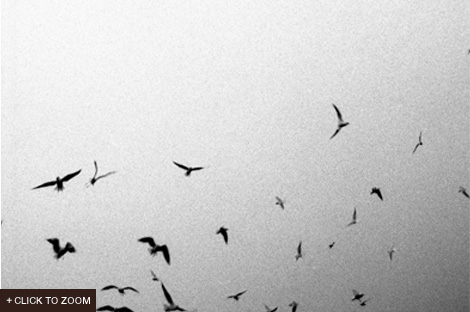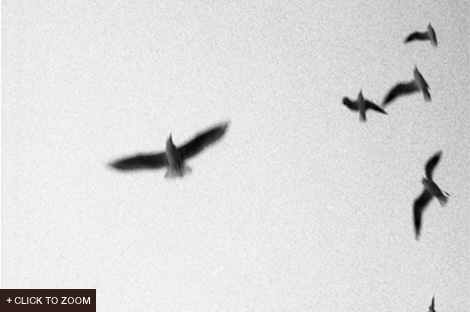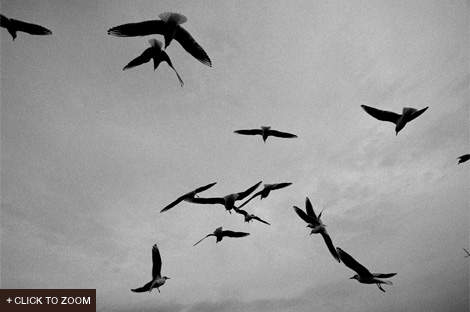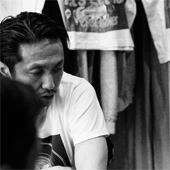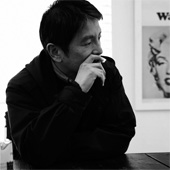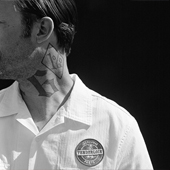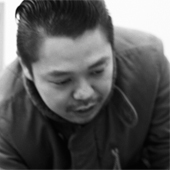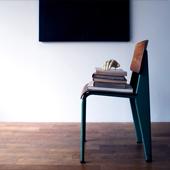
このシリーズの鳥は模様でも形でもあるので、真っ白なキャンバスにインクを蒔いてるような感覚でもあるんですよ。バッと飛び散ったインクの“この部分だけ好き”みたいな。その感覚がすごく有機的なセッションだとも思うんです。
そうかもしれないですね。大判のカメラは不思議とパブリックな感じがするけど、35mmはより私的な感じがしますしね。フィルムのカメラってたくさん種類があって、僕はいろいろなカメラを使いますが、それはその時の自分の感情とカメラの特性のマッチングで選びます。対ヒトになった場合は、あえて8×10インチの大判を使って被写体を緊張させたり、逆に35mmで話しながらリラックスさせてノーファインダーで撮ったりもするけど、カメラの特性って写真家の武器の特性でもあるんですよ。例えば、小さなシャッター音のカメラ、大きな目のような印象のレンズ、三脚でかまえて撮るなどそれぞれの特性で撮れる写真が変わってくる。ファッションではそこに自分の撮るリズムが加わって、相手が撮ってほしいリズムみたいなものとの調和とか不調和とかが出てくる。
TRAVERSEの“THINGS”のページでは、最初に庭の写真をアップし始めたんです。ここ最近ずっと庭という概念に興味があって、デレク・ジャーマン個人の最期の庭から京都の日本庭園、そして世界の風景、自分の体験した風景へと繋げていっています。ただ、あのページはフォトログとして捉えているので、そこに対して特に深いコンセプトを持っているわけではないですが、前の写真をふまえて旅してゆく感じにはなっています。“In the Garden”のシリーズの導入にはなっていますね。
元々はベタに京都の龍安寺の枯山水に対する興味から始まっているんですが、日本庭園が好きなんです。龍安寺から銀閣寺で完全にはまって、苔寺や天竜寺、今は夢窓疎石という人の作品に興味があって撮っています。見る人や見る季節、時間やその時の気持ちによっていろんな表情を見せる、どこか四次元的な感じがすごく好きです。銀閣寺は例えば、家主が立って見渡す位置から庭を見ると、まず手前に社会というか支配されたバビロンがあって、そこから先に残された自然があって、さらには人が手に入れてはいけない自然が出てくる、という感じに僕は見えます。手前に置く木や砂の造形をわざと大きくして、遠くにはすごく小さいけれど、よく見ると細かいディテールのある苔や盆栽のような木を置いたりするパースの使い方だったり、自然に地面に枯れ落ちるボタンの花などは、世界や生命、宇宙を表現していたりもする…。その空間に何かを閉じ込める力がある庭を見ると、本当にすごいと思います。イサム・ノグチやアンディ・ゴールドワージーなどで代表される「ランドスケープアート」ってコトバがありますが、その本質的な起源だと感じます。
すべては、その場で見なければ何も伝わらないぐらい圧倒的な場の力があるので、それを自分の目で切り取って断定させていく作業はすごく面白いです。どこまで実感し写真にできるのか、ある種の実験みたいな感覚。それは情報過多になって、実態がなくなっていくような同時代性にはすごく重要な体験です。“.mp3”ではなく、ライブに行くような感覚というか…。時間や情景がダイレクトにその空間の素材になって体に伝わってくる。デレク・ジャーマンも自分の圧倒的な内なる世界と、最期の魂を投影した庭を作っています。しかもミニマルに。病気になってから住み移った原子力発電所の近くの家の庭は、切なくも何かを訴え続けるように残っています。その刹那的な美学はある意味で日本庭園で表現されているものと同じような感覚だと思うんです。そんな庭をモノクロの写真で撮りためることを続けていければと思っています。閉ざされたおかげで無限に広がっていくベクトルを想像させるような感覚です。それは写真のフレーミングに似たような感覚になって、とても写真的です。基本的なことだけど、モノクロ写真って不思議で、色数を制限されているので情報量が少ないかと思いきや、想像させる力がある分、人の見方によっては10倍にも20倍にも感覚的になる。本物を見極めなきゃいけない、デジタル社会のメディアリテラシーに通ずる感覚にとてもリンクするように思えます。
The birds in this series are patterns and figures at the same time, so there is this sense of spreading ink on a white canvas. When the ink would spatter, and I would greatly be attracted to a certain area– I think that is a very organic session.
Probably. The large format somehow feels public, but 35mm feels more private. There are many kinds of film cameras, and I use varying types; how I feel in that moment and the unique qualities of that camera, I choose by that special “matching.” When interacting with people, I use a 8x 10 large format and make them nervous, or use a 35mm, making them relaxed, chatting with them, and photograph them without a finder, the characteristics of the camera is one component of the photographer’s tool as well. For example, a camera with a soft shutter sound, a lens that reminds us of a large eye, a camera attached to a tripod – each of these characteristics of the physical camera will change what we can express in the photograph. In fashion photography, with the rhythm of me taking pictures, there would be a harmony or a discord with the rhythm that the subject would want to be shot with.
On the TRAVERSE page of “Things,” was where I first uploaded photographs of a “garden.” Recently I have become quite interested in the concept of a garden; from Derek Jarman’s personal gardens to Kyoto’s Japanese style gardens, the world’s scenery to anything I have witnessed-- I connected them all together. But this page was just a“photolog,” so I did not necessarily have a complicated concept behind it, although I do think there has been a departure from my previous photography. This essentially helped create the “IN THE GARDEN” series.
It really first started with my deep fascination of Kyoto’s Ryo-an Temple and the rock garden located there, but I just really loved traditional Japanese style gardens in general. From the Ryo-an Temple and Ginkaku Temple, I got hooked, including the the Koke Temple to the Ten-RyuTemple, I am now so intrigued in Musou Soseki’s artwork I have been photographing them. The viewer watching, and the season being watched, that specific moment in time, and your expression depending on what you feel; I love that sort of “fourth-dimension” type sensation. The Ginkaku Temple for example, viewing the garden from where the temple owner stands, first there is society or the controlled Babylon before you, then what is left of the nature life, and then there is the nature that is just out of human kind’s grasp-- I see all of that, in that procession. Experimenting with perspective by making the trees or the sand sculptures larger on purpose but from far away they look small, and if you look closely you can see the fine details of the moss or bonsai like trees, or the peonies naturally withering away, falling to the ground; this represents the world, life, and space. I think it is truly amazing, examining a garden that has that power to withhold something in that space... There is the term “landscape art” well known because of Isamu Noguchi or Andy Goldsworthy, but I feel as though this is the origin of it.
This all has such an overwhelming power that you cannot even feel it unless you view it at the actual location, so this process of me judging and creating it with my own eyes is actually very fun. How much I can feel and then make into a photograph—it is sort of an experiment. Recently everything is just too much information at once, so I believe this is an important experience for people today where they are losing the actual real sensation. Think of it as going to a live concert compared to just the “.mp3”... The moment in and time and whatever you see directly builds into the moment and then transmitted to the body. Derek Jarman also creates gardens that are projected from his soul with everything he had left in him, and the vast world he lives in. He then even keeps it very simple. The garden by his house, which he moved to after he got sick, near a nuclear power plant is still there, as though it is trying to say something. I think this subtle aesthetic is a similar sensation represented in a Japanese garden. And I would like to continue to photograph these gardens in black and white. Because it is already enclosed, I can imagine it as this endless vector. And this is similar to how you frame a photograph, so it’s very photography-like. This is very fundamental, but black and white photographs are interesting because there seems to be a limited number of color used therefore less information, butthis makes it ten, twenty times more stimulating for the viewer. I think this can link well with the digital industry’s media literacy, where you have to closely examine the true subject.













